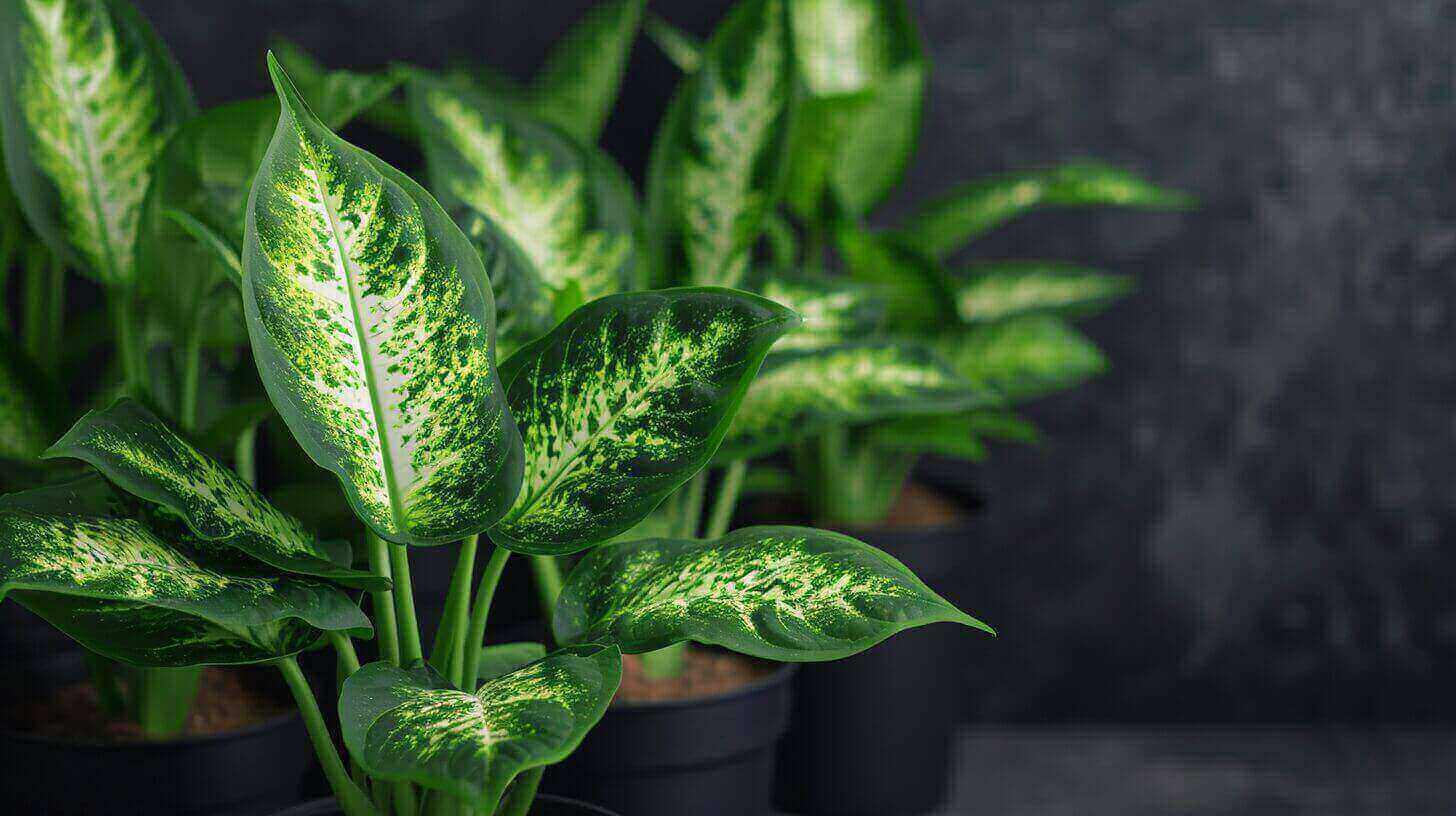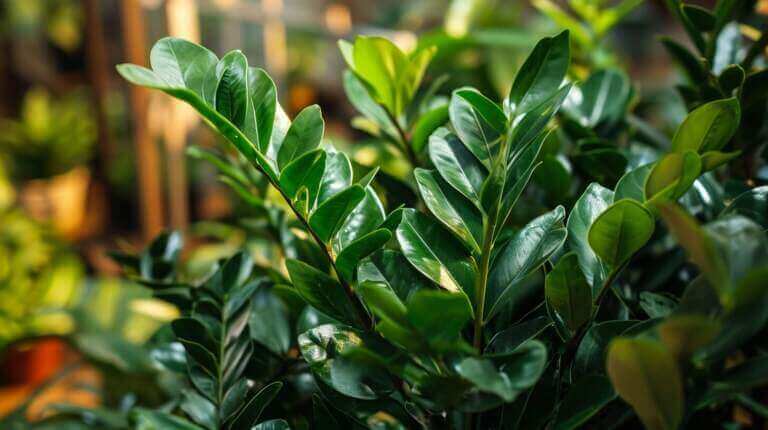How To Propagate Dieffenbachia or Dumb Cane Plant: A Step-by-Step Guide for Beginners
If you’re a beginner and want to learn how to propagate Dieffenbachia plants, you’ve come to the right place. In this step-by-step guide, I will walk you through the process of propagating these beautiful plants, whether you choose to use stem cuttings or air layering. By following these simple instructions, you’ll be able to successfully multiply your Dieffenbachia collection and enjoy the beauty of these stunning plants in your home or garden.
Key Takeaways:
- Dieffenbachia plants can be propagated through stem cuttings or air layering.
- Sterilize pruning shears before taking cuttings and choose healthy stems.
- Stem cuttings should be placed in a rooting medium or water and kept in a warm location.
- Air layering involves making a slit in the stem, wrapping it in moist moss, and covering it with plastic film.
- Once roots have formed, the new plants can be potted in a well-drained potting mix.
Propagating Dieffenbachia Plants through Stem Cuttings
Stem cuttings are a popular and straightforward method for propagating dieffenbachia plants. To begin, wear gloves and sterilize pruning shears before selecting a healthy stem for cutting. Cuttings can be taken from the tip, base, middle, or lower section of the stem, depending on your preference. It’s advisable to take multiple cuttings to increase the chances of success.
Once you have selected the stem, make sure your cuttings are at least 3-4 inches long. Remove any leaves from the lower section of the cutting and allow it to dry overnight or place it in direct sunlight. This step helps to prevent the cutting from rotting during the rooting process.
Next, prepare a rooting medium by combining sand and peat moss. Dip the bottom end of the cutting in a rooting hormone and insert it horizontally into the prepared potting mix. Ensure the cutting is securely planted and the potting mix is kept moist. You can cover the cuttings with plastic sheets to maintain constant humidity, promoting root growth.
| Steps for Propagating Dieffenbachia Plants through Stem Cuttings | Materials Needed |
|---|---|
| 1. Select a healthy stem and sterilize pruning shears. | – Gloves – Pruning shears (sterilized) |
| 2. Take cuttings from the desired section of the stem. | – Cutting (3-4 inches long) – Rooting hormone |
| 3. Remove lower leaves and allow the cutting to dry. | – Plastic sheets (optional) |
| 4. Prepare a potting mix of sand and peat moss. | – Sand – Peat moss |
| 5. Dip the cutting in rooting hormone and insert it horizontally into the potting mix. | – Rooting hormone – Plastic sheets |
| 6. Keep the potting mix moist and ensure the cutting is securely planted. | – Water |
The rooting time for stem cuttings is typically 4-8 weeks. Once the cuttings have developed a strong root system, they can be transplanted into a larger pot or directly into the garden. Remember to provide adequate care and maintenance for the newly propagated dieffenbachia plants to ensure their long-term health and growth.
Propagating Dieffenbachia Plants through Air Layering
Air layering is an effective method for propagating larger dieffenbachia plants, especially those with leggy leaves or fading color. By creating a conducive environment for root growth on the plant itself, air layering allows for the development of robust new plants. Here’s a step-by-step guide on how to propagate dieffenbachia plants through air layering.
Selecting a Suitable Stem
Start by identifying a healthy stem on the dieffenbachia plant that you wish to propagate. The stem should be thick enough to make a small incision and have several nodes along its length. Nodes are the points on the stem where leaves or branches emerge. Choose a stem with enough space between the nodes to accommodate the rooting medium.
Preparing the Stem
Make a clean, horizontal incision on the selected stem, about one-third of the way through its diameter. Insert a toothpick or small twig into the incision to hold it open. This ensures that the rooting medium comes into direct contact with the wounded section of the stem. Dust the cut portion with a rooting hormone to stimulate root development.
Wrapping and Rooting
Moisten sphagnum moss and wrap it around the wounded section of the stem, making sure to cover the cut area completely. Secure the moss with string or tape to keep it in place. Next, cover the moss-wrapped area with clear plastic film, ensuring there are no air pockets. This creates a humid environment that promotes root growth. Keep an eye on the moss, moistening it as needed to maintain humidity.
After a few days, roots should start to develop within the moss. Once the roots are visibly established, carefully remove the plastic film. Using a clean pair of sharp pruning shears, cut the newly rooted branch from the parent stem just below the moss-wrapped area. Gently plant the newly rooted branch in a pot filled with high-quality potting mix, ensuring the roots are completely covered. To encourage further root growth, you may choose to cover the newly potted plant with plastic film again until the roots have properly established.
Air layering is a reliable method for propagating dieffenbachia plants, allowing you to create new plants that are genetically identical to the parent plant. By following these steps, you can successfully propagate your dieffenbachia plants through air layering and enjoy a flourishing collection of these beautiful tropical plants.
Propagating Dieffenbachia Plants through Division
Division is another effective method of propagating dieffenbachia plants. This method involves separating offshoots from the parent plant, allowing them to develop into new individual plants. It is a simple technique that can be done by beginners with ease.
To begin the process, gently remove the parent plant from its pot and clear away the soil from the roots. Look for offshoots that have developed their own root system. These offshoots will have at least one node on either side, indicating their readiness for separation.
Carefully separate the offshoots from the parent plant, ensuring that each new plant has its own root system intact. Plant the offshoots in individual pots filled with prepared potting mix, providing them with enough space to grow. Water the new plants well, allowing the soil to become moist but not waterlogged.
It is important to note that dieffenbachia plants contain a toxic sap, so it is recommended to wear protective gloves when handling them. Additionally, any residual sap should be washed off from hands and tools to prevent irritation. Keep the plants out of reach of pets and children to avoid any accidental ingestion.
Division Method Summary:
- Remove parent plant from the pot and clear away soil from the roots.
- Identify offshoots with developed root systems and at least one node on either side.
- Gently separate offshoots from the parent plant.
- Plant offshoots in individual pots with prepared potting mix.
- Water the new plants well, ensuring the soil is moist but not waterlogged.
- Wear protective gloves and wash hands/tools to avoid sap irritation.
- Keep plants out of reach of pets and children due to their toxic nature.
With proper care and attention, the offshoots will grow into healthy, vibrant dieffenbachia plants, giving you a beautiful addition to your indoor or outdoor garden.
| Advantages of Division Propagation | Disadvantages of Division Propagation |
|---|---|
| – Easy method for beginners | – Limited number of offshoots |
| – Offshoots have developed root systems | – May take longer for new plants to reach maturity |
| – Allows for the creation of multiple plants from one parent | – May require larger pots for each new plant |
“Division propagation is a great way to expand your dieffenbachia plant collection. By separating offshoots from the parent plant, you can create multiple plants that will thrive in their own individual pots. Just remember to take the necessary safety precautions when handling dieffenbachia due to its toxic sap.”
Safety Tips for Propagating Dieffenbachia Plants
When propagating dieffenbachia plants, it’s crucial to prioritize safety to prevent any potential harm or irritation. Dieffenbachia plants contain a poisonous sap that can cause discomfort and skin irritation. To protect yourself, always wear protective clothing, gloves, and a face mask when handling the plant to avoid direct contact with the sap.
Additionally, it’s important to be mindful of touching your eyes after handling dieffenbachia, as it can cause itching and irritation. To avoid any potential issues, it’s best to wash your hands thoroughly after working with the plant.
Furthermore, dieffenbachia plants should be kept out of reach of both pets and children. Ingestion of the leaves can lead to burning sensations and temporary paralysis. It’s crucial to keep the plants in a pet-free and child-free area to ensure their safety. If necessary, consider relocating the plants to a more secure location.
FAQ
What is the best way to propagate a dieffenbachia plant?
The easiest way to propagate a dieffenbachia plant is through stem cuttings. Cut a piece from the main stem, ensuring it has at least one leaf joint. Place the cutting in a pot with moist potting soil and keep the soil moist until new roots develop.
How do you care for a dieffenbachia houseplant?
Dieffenbachia care involves providing indirect light and keeping the soil moist but not waterlogged. The dieffenbachia prefers temperatures between 60-80°F and high humidity.
Can you grow a new dieffenbachia from cuttings?
Yes, you can grow a new dieffenbachia from cuttings. Place the dieffenbachia cuttings in a pot with moist potting soil. New growth should appear in a few weeks.
Where can I buy a dieffenbachia plant?
Dieffenbachia plants, also known as dumb cane, can be purchased from most garden centers or online plant retailers.
How do you propagate a dumb cane plant?
Propagating a dumb cane plant is similar to propagating a dieffenbachia. Cut a piece from the end of the stem and place it in a pot with moist soil. Keep the soil moist and place the pot in a location with indirect light.
How do you propagate a dieffenbachia through division?
Dieffenbachia can be propagated through division by separating the baby plant from the main stem. This is usually done during repotting. The new dieffenbachia plants should be placed in a pot with moist soil and indirect light.
What is the best way to grow dieffenbachia?
The best way to grow dieffenbachia is to provide it with indirect light, keep the soil moist, and maintain a temperature between 60-80°F. Dieffenbachia is also known as a great indoor plant due to its adaptability to various indoor conditions.







